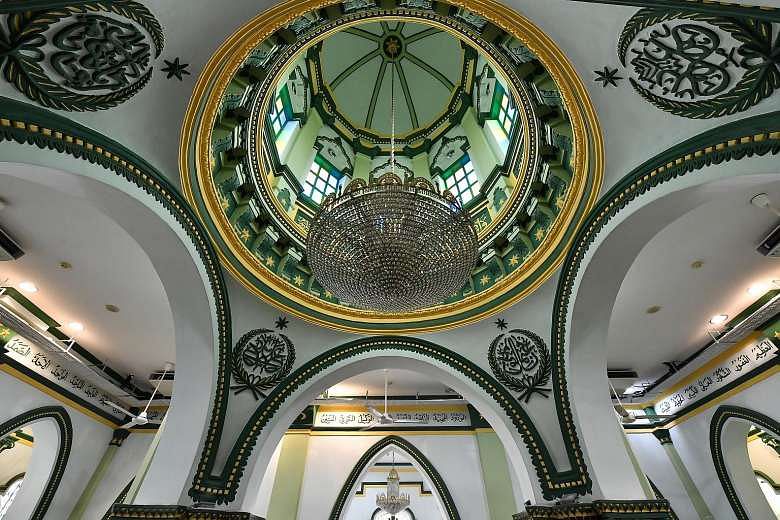It is the sunburst engraving above the entrance of Abdul Gafoor Mosque that catches the eye.
Inscribed on it are the names of 25 major Islamic prophets in brilliant yellow Arabic script against a deep green background.
Mosque manager Fareed Maricar proudly boasts that this is the only mosque here with such a feature.
The 41-year-old adds that most visitors, after marvelling at the engraving, ask him where the mosque's dome is - do mosques and domes not go together, they wonder.
He would tell them: "Yes, there is a dome. But it is slightly hidden farther back on the roof."
These are just two of the features of the mosque in Dunlop Street, a national monument gazetted in 1979 and one of Singapore's oldest Muslim houses of worship.
A Lonely Planet entry on Singapore attractions notes that the mosque "serves up a storybook fusion of Moorish, southern Indian and Victorian architectural styles".

Its history dates back to 1859, when Al-Abrar Mosque stood in the same plot.
Also known as Dunlop Street Mosque, it served south Indian muslims and Baweanese horse groomers - who hailed from Indonesia's Bawean Island - in the Kampong Kapor area.
From the 1880s, the chief clerk of the law firm Khory & Brydges, Shaik Abdul Gaffoor Shaik Hyder, started building shophouses and sheds in the area, which were rented out to raise funds to build a new mosque.
The Indian Muslim from Tamil Nadu was one of the two trustees of the mosque's endowment, along with Mr Ismail Mansor.
In 1907, the new mosque began construction and after Shaik Abdul Gaffoor died in 1919, the mosque was named after him.

Some of the shophouses currently stand within the mosque's compound just opposite the main prayer hall, with students filling them on weekends for religious lessons.

The exterior of the mosque was originally painted off-white, but took on the striking hues of yellow and green after a refurbishment in 2003.
It is due soon for another facelift, with details to be announced within the next few months.
Its location in Little India ensures that many pass through its gates. There are about 4,000 visitors on weekends, and around 2,000 to 3,000 on weekdays, said Mr Fareed.
Visitors can learn about the mosque and enjoy a free bottle of cold water at its small visitor centre in the corner of one of the former shophouses.
Today, the mosque serves mainly Indian Muslims.
There are about 90,000 Tamil Muslims in Singapore and Abdul Gafoor Mosque is one of six Singapore mosques that regularly conducts sermons in Tamil.
It is so famous in Tamil Nadu that it drew an Indian imam to Singapore to become its spiritual head.
"Everyone from my home town that comes to Singapore will visit Abdul Gafoor Mosque," said Mr Abdul Malik Mohamed Azeezullah, who hails from Tiruchirappalli in Tamil Nadu state.
The 32-year-old, who worked as both an imam and an Arabic language professor in his home town, began his new job here 10 months ago.
Abdul Gafoor Mosque has one of the highest proportions of foreigners in its congregation, among mosques in Singapore. Foreigners make up about one-third of its worshippers, said Mr Fareed.
One of these foreigners is Mr Abdulgani Shaik, 32, from Tamil Nadu, who works as a site supervisor here.
He has been visiting the mosque for nearly eight years and spends a lot of his time there.
He said in Tamil: "I love this mosque because I have built a network of friends and I treasure them."
He also appreciates its rich tradition and Tamil-language sermons, he said, adding that the mosque reminds him of home.
Another devotee is perfume store owner Mohamed Ghazzali, an India-born Singaporean who lives and works nearby, and has worshipped at the mosque for about 30 years.
Mr Ghazzali, 52, also volunteers at the mosque, and said he likes the fact that it has a visitor centre and enjoys telling non-Muslim visitors about Islam.
He said: "When I'm entering the mosque, I feel like I'm gathering with the members of my family."
Mr Fareed feels similarly. His extended family meets at the mosque on special occasions such as Hari Raya, and he loves the calm here.
He said: "It's the tranquillity and peace. It's not in all places that you'll feel as if you're coming into your own home."

